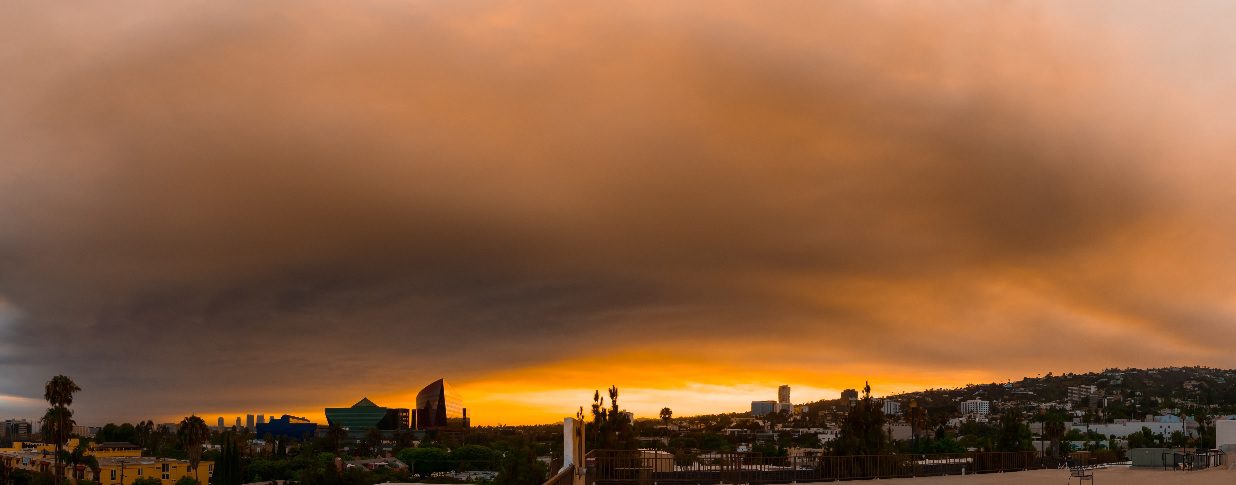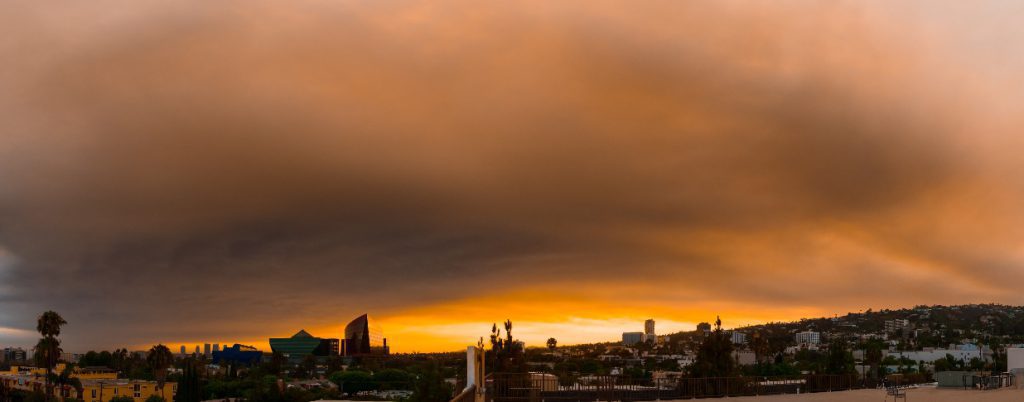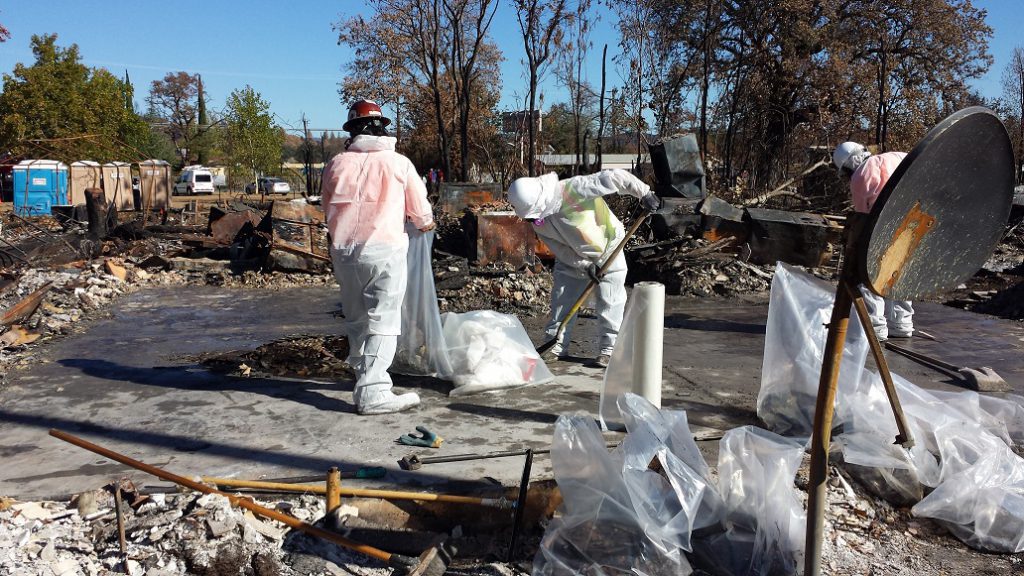
California Wildfires and Smoke Inhalation Hazards

Written by: Brittiny Harris, NES, Inc.
 Smoke from 2017 California wildfires has inundated urban areas, creating low air quality and presenting severe smoke inhalation hazards.
Smoke from 2017 California wildfires has inundated urban areas, creating low air quality and presenting severe smoke inhalation hazards.
Wildfires Create Smoke Inhalation Hazards
California is dealing with one of the most disastrous fire seasons in its history, and with these fires come serious smoke inhalation hazards. An October 16, 2017 article entitled Cal/OSHA: Wildfire Smoke Creates Hazards for Workers states that northern California has more than 100,000 acres on fire and 40 people have been reported dead.
The loss of life is tragic, and the loss of property is extreme. Beyond these concerns, fires have ravaged many California cities and surrounding areas, spewing huge amounts of smoke into the atmosphere and covering surfaces in a thick layer of toxic ash. Smoke inhalation hazards are a prominent problem that firefighters (and firefighters’ support personnel), cleanup crews, industrial hygienists, private citizens, and all others in the affected regions are dealing with and will continue to encounter as a result of these wildfires.
Many of these smoke inhalation hazards are created not only from the burning trees and grass but from burning houses. As they burn, houses produce highly dangerous gases, chemicals, and fine particles that can cause severe health issues if inhaled. The paint, metal, batteries, and many more products commonly found in and around houses create dangerous fumes causing serious smoke inhalation hazards for employees trying to contain the fire and for residents in the area.
Given the massive scope of the 2017 California wildfires, a tremendous amount of smoke and ash has been released into the atmosphere. It is therefore important to realize that prevailing winds can carry significantly dangerous quantities of smoke tens and even hundreds of miles from its originating source.
OSHA Warns About Smoke Inhalation Hazards
The Occupational Safety and Health Administration (OSHA) has taken action to advise employers on how to protect their employees from smoke inhalation hazards and from the painful side effects of the ash toxins. OSHA advocates three different methods to protect people who are close to the fire and dealing with smoke inhalation hazards.
Smoke Hazard Safety Measures
Engineering Controls
OSHA’s first recommendation is to always have engineering controls in place. These include keeping indoor areas smoke free with clean air from ventilation systems. The general population has been advised to adjust air-conditioning units and use car vent systems to recirculate the air in order to avoid allowing outside air into the car.
Administrative Controls
The next line of defense endorsed by OSHA is administrative controls. When smoke inhalation hazards are present, keep employees, children, and the general population around the affected areas indoors. Limit time spent outside whenever possible.
Personal Protective Equipment
OSHA also recommends employees use personal protective equipment (PPE), specifically respirators along with any barriers that can be used between your skin and the hazardous smoke.
OSHA does specify that respirators are only needed if the air is designated to be “unhealthy”, “very unhealthy”, or “hazardous” according to California Code of Regulations (CCR) Title 8 §5141 General Industry Safety Orders. N95s disposable respirators through P100s respirators are not required to be fit-tested, but they do come with user instructions and are a valued option for PPE. OSHA urges respirator users to shave facial hair and to avoid wearing a hat over the straps of the mask in order for it to fit correctly. OSHA, however, does recognize that the respirators do not protect against exposure to gases, vapors, oils, pesticides, and other chemicals. It should also be noted that the respirators do not provide oxygen, they only filter out harmful particles; because of this, there is a higher risk of heat illness among those who already have trouble breathing.
OSHA cautions employees who are using a respirator to always be aware of how they are feeling while using the respirator. If the employee is feeling dizzy, faint, lightheaded, nauseous, or disoriented in any way, he or she should remove the respirator, proceed to a safer area, and get medical attention. Employees are advised to use a new respirator every day and dispose of dirty respirators and any respirators that become hard to breathe through.
PPE for the General Public
Needless to say, not only employees are being advised to wear PPE. The general public is also put at risk by smoke inhalation hazards. One woman who was interviewed for the seeker.com article Air Quality Plummets as Wildfires Rage, Putting Public Health at Risk shared her concerns about smoke inhalation hazards in her house in Santa Rosa. She had already had regular problems with the cold leaking into her house; now it is the smoke that she cannot keep out!
The above video from the California Air Resources Board provides information about simple steps that can be taken to reduce exposure to smoke inhalation hazards.
Dangers of Smoke Inhalation
Doctors are most concerned about people’s health as impacted by the increased presence of particulate matter (PM), meaning the light ash and dustlike soot found in the smoke. Most of this PM is invisible to the human eye. The worries with this miniscule dust and ash being breathed in is that it can get past the body’s natural filtration system and infiltrate deep into the lungs, reaching the alveoli. It can even get into the bloodstream.
PM 10 is dust and ash that is less than 10 microns wide that can be breathed into the lungs and enter the bloodstream. As a comparison, human hair is about 60 microns wide. PM 2.5 is the most lethal hazard found in the dust and ash. Side effects from the inhalation of PM 2.5 include premature death, chronic obstructive pulmonary disease (COPD), and elevated risk of heart attack.
Smoke inhalation hazards can also contribute to reduced lung function, increase asthma symptoms, coughing, wheezing, and other breathing problems. After a few days of exposure to the hazardous smoke, the lungs can become so damaged that they break down, potentially leading to bronchitis or pneumonia. With pregnant women, premature births and low birth weights in infants have been found to correlate with exposure to smoke inhalation hazards.
In this video Dr. Cedric Jamie Rutland “Dr. J” explains the adverse effects of smoke inhalation on the lungs.
Burning Houses Contribute to Smoke Inhalation Hazards
Dangerous toxins are swirling in the air causing serious smoke inhalation hazards for anyone in the general area. These toxins are found in natural (trees, grass, etc.) wildfire smoke such as gases and particles that contain carbon dioxide, carbon monoxide, and other organic chemicals; but the most severe smoke inhalation hazards come from burning houses. These burning houses contain toxins such as pesticides, propane, gasoline, paint, etc. Houses that contain treated wood to prevent bacteria growth can contain copper, chromium, and arsenic. Electronics that contain metals such as mercury and lead are typically found in modern houses; older houses that might have been built with asbestos insulation, asbestos shingles, or other asbestos-containing products can create particularly significant smoke inhalation hazards.
For more information about asbestos and asbestos-related illnesses, view the August 2017 NES article Mesothelioma Awareness and Occupational Health & Safety.
 Burned houses release toxic fumes into the air and remain a hazard after the fire has been extinguished.
Burned houses release toxic fumes into the air and remain a hazard after the fire has been extinguished.
Bay Area Air Quality Plummets
With all of these dangerous toxin-containing materials going up in flames, smoke inhalation hazards are swirling throughout northern California. The undark.com article Far From California’s Fires, Smoke Poses a Hazard, Too reports that the Bay Area, while as much as 100 miles from current fires, was recorded on Thursday, October 12, 2017, to have uncomfortably high levels of PM 2.5. The Environmental Protection Agency (EPA) lists air quality up to 50 micrograms of PM 2.5 per cubic meter as “good”. In San Francisco on that Thursday, the air quality was recorded as 158 micrograms per cubic meter. The EPA labeled San Francisco as “unhealthy” air quality. Not only is the air unhealthy, but the soil is gathering higher levels of toxins than recommended for public safety.
CBS SF Bay Area reports that the smoke reached such dangerous levels in the San Francisco area that officials were forced to postpone school events.
Help and Health After the Fires
The initial fires have created large levels of smoke inhalation hazards, and the cleanup of these devastating fires is bound to create a new set of hazardous issues. Not only are residents worried that the cleanup will go on for years, the cost of the cleanup has residents on edge. On top of the associated time and costs, liabilities of the dangers of cleaning up have federal and state agencies preparing to keep employees safe.
According to a The New York Times article entitled Cleanup From California Fires Poses Environmental and Health Risks, the order of operations for cleanup insofar as government agencies are concerned is not officially established. However, it is anticipated that the California Department of Toxic Substances Control (DTSC) will likely be the first step in the cleanup and recovery process. DTSC will come in and remove the most hazardous materials debris such as asbestos, paints, batteries, electronic waste, and flammable liquids. The California Department of Resources Recycling and Recovery (CalRecycle) will be the logical second step of recovering property. CalRecycle will remove metals, concrete, ash, and contaminated soil. Afterwards, the land can be prepared for rebuilding, and the Federal Emergency Management Agency (FEMA), which generally concentrates on recovering and rebuilding public property, may be authorized to step in and lend a helping hand.
Public Safety During Cleanup
As for cleaning up private property, be safe! People have been digging through the ash on their cars and personal items without PPE. Do not do this. The cleanup will be paid for by taxpayer funds or private insurance (if applicable to the homeowner’s policy). A contractor that has been approved can be hired if wanted.
The ash that is being cleaned up from the burned homes contains toxins and chemicals that are dangerous. Avoid stirring the ash into the air or getting the ash on your skin. Use water and wet cloths in order to wet down the ash for the sake of keeping it out of the air. Do not use a leaf blower to move the ash and avoid sweeping the ash. Instead, use a high-efficiency particulate air (HEPA) vacuum in order to safely remove the ash. Always protect yourself before trying to clean any area that has been affected by the fires.
 It is imperative to wear proper PPE during site cleanup.
It is imperative to wear proper PPE during site cleanup.
NES’ Industrial Hygiene Services
NES has been providing industrial hygiene services on behalf of a wide array of public and private businesses and government agencies for the past 30 years. If you have questions regarding smoke inhalation hazards, air quality, substances testing, and/or remediation safety oversight at your home or business, please contact NES at office@nesglobal.net or 916-353-2360 / 1-800-NES-ADVISE.
References:
Cal-OSHA Reporter Article: A Smoky Threat to Outdoor Workers
EHS Today Article: CAL/OSHA: Wildfire Smoke Creates Hazards for Workers
California Regulations: 8 CCR §5141: General Industry Safety Orders
Seeker.com Article: Air Quality Plummets as Wildfires Rage, Putting Public Health at Risk
California Air Resources Board YouTube Video: Protect Yourself from Wildfire Smoke
Sfgate.com article: Health Hazard from Fires’ Smoke Spreads Throughout Bay Area
KQED News Article: Doctors Warn Against the Toxins and Triggers Hidden in Wildfire Smoke
Medicine Deconstructed with Cedric Jamie Rutland MD YouTube Video: Smoke Inhalation Injury (Wild Fire Worries)
Undark.org Article: Far From California’s Fires, Smoke Poses Hazard, Too
CBS SF Bay Area YouTube Video: Wildfire Smoke Smothers Bay Area for Fifth Straight Day
The New York Times Article: Cleanup From California Fires Poses Environmental and Health Risks
Sierra Sun Times Article: California State Health Officer Urges Caution During Wildfire Cleanup
